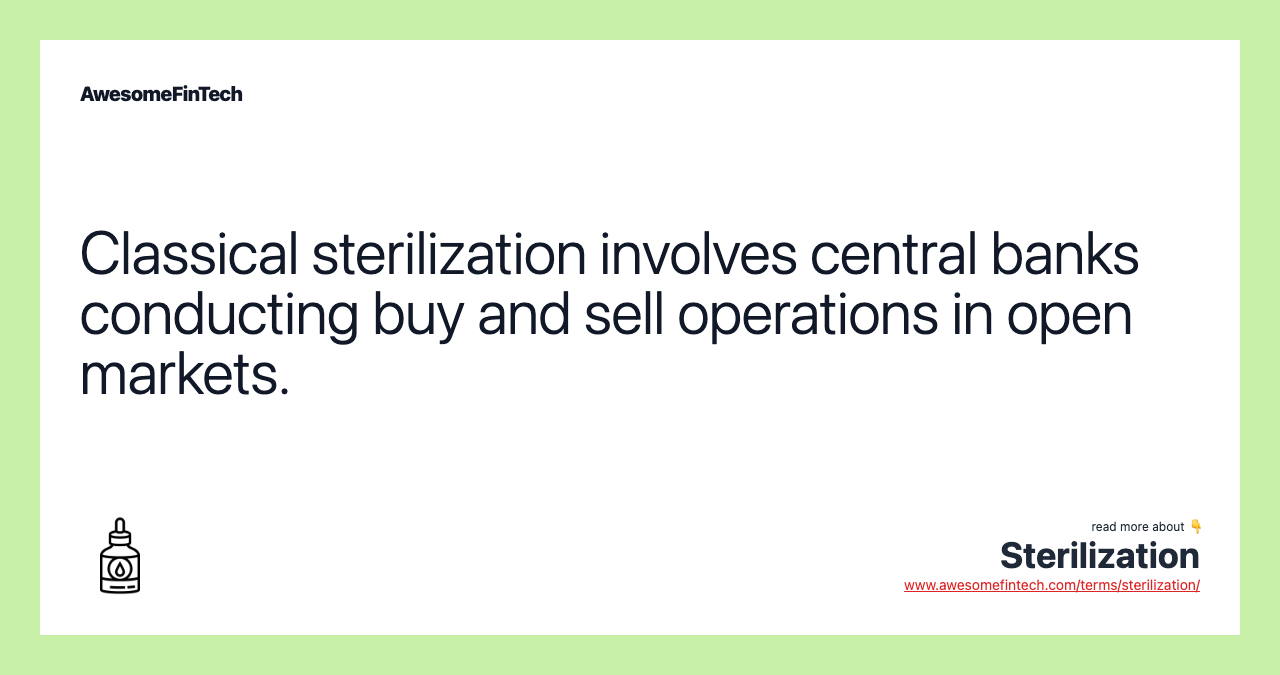Sterilization
Sterilization is a form of monetary action in which a central bank seeks to limit the effect of inflows and outflows of capital on the money supply. A central bank can also intervene in foreign exchange markets to prevent currency appreciation by selling its own currency in exchange for foreign currency-denominated assets, thereby building up its foreign reserves as a happy side effect. At this point, the Indian central bank can either let the fluctuation continue, which can drive up the price of Indian exports, or it can buy foreign currency with its reserves in order to drive down the exchange rate. If the central bank decides to buy foreign currency, it can attempt to offset the increase of rupees in the market by selling rupee-denominated government bonds. Sterilization most frequently involves the purchase or sale of financial assets by a central bank and is designed to offset the effect of foreign exchange intervention.

More in Economy
What Is Sterilization?
Sterilization is a form of monetary action in which a central bank seeks to limit the effect of inflows and outflows of capital on the money supply. Sterilization most frequently involves the purchase or sale of financial assets by a central bank and is designed to offset the effect of foreign exchange intervention. The sterilization process is used to manipulate the value of one domestic currency relative to another and is initiated in the foreign exchange market.



Understanding Sterilization
Sterilization requires a central bank to look beyond its national borders by getting involved in foreign exchange.
As an example, consider the Federal Reserve (Fed) purchasing foreign currency, in this case the yen, with dollars that it has in its reserves. This action results in there being less yen in the overall market — it has been placed in reserves by the Fed — and more dollars, since the dollars that were in the Fed’s reserve are now in the open market.
To sterilize the effect of this transaction, the Fed can sell government bonds, which removes dollars from the open market and replaces them with a government obligation.
Problems with Sterilization
In theory, classical sterilization, such as the one described above, should counteract the negative effects of capital inflows. However, that may not always be the case in practice.
Money spent buying foreign assets initially goes to other countries, but it soon finds its way back into the domestic economy as payment for exports. The expansion of the money supply can cause inflation, which can erode a nation's export competitiveness just as much as currency appreciation would.
The other problem with sterilization is that some countries may not have the tools to effectively execute sterilization in open markets. A country that is not fully integrated with the world economy may find it difficult to conduct operations in the open market.
For example, developing countries may not have sophisticated financial instruments to offer for investment to foreign investors. Central banks may also have to deal with operating losses since they are required to conduct transactions in foreign currencies for their portfolio of assets. This problem can be especially big for developing countries due to the imbalance in exchange rates.
Special Considerations
To overcome these problems, countries often resort to strategies that combine classical sterilization with other measures. For example, they might ease capital controls and reserve requirements at domestic financial institutions to encourage outflows and bring balance into the economy.
They may also conduct foreign exchange swaps by selling foreign currency against the local one and promising to buy it back at a later date. Other tools in a central bank's policy arsenal are shifting public sector deposits from commercial banks to the central bank and making it difficult for the general public to access credit.
Example of Sterilization
Emerging markets can be exposed to capital inflows when investors buy up domestic currencies in order to purchase domestic assets. For example, a U.S. investor looking to invest in India must use dollars to purchase rupees. If a lot of U.S. investors start buying up rupees, the rupee exchange rate will increase.
At this point, the Indian central bank can either let the fluctuation continue, which can drive up the price of Indian exports, or it can buy foreign currency with its reserves in order to drive down the exchange rate. If the central bank decides to buy foreign currency, it can attempt to offset the increase of rupees in the market by selling rupee-denominated government bonds.
Related terms:
Capital Control
Capital control is an action taken by a government, central bank, or regulatory body to limit the flow of foreign capital in and out of a domestic economy. read more
Central Bank
A central bank conducts a nation's monetary policy and oversees its money supply. read more
Credit
Credit is a contractual agreement in which a borrower receives something of value immediately and agrees to pay for it later, usually with interest. read more
Currency Appreciation
Currency appreciation is the increase in the value of one currency relative to another in forex markets. read more
Currency
Currency is a generally accepted form of payment, including coins and paper notes, which is circulated within an economy and usually issued by a government. read more
Currency Board
A currency board is an extreme form of a pegged exchange rate. Often, it has directions to back all units of domestic currency with foreign currency. read more
Emerging Market Economy
An emerging market economy is one in which the country is becoming a developed nation and is determined through many socio-economic factors. read more
Exchange Rate
An exchange rate is the value of a nation’s currency in terms of the currency of another nation or economic zone. read more
Export
Exports are those products or services that are made in one country but purchased and consumed in another country. read more
Financial Instrument
A financial instrument is a real or virtual document representing a legal agreement involving any kind of monetary value. read more